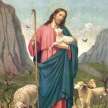Saint Patrick (387- 461CN)
Saint Patrick: Apostle of Ireland and Miracle Worker

Saint Patrick, the patron saint of Ireland, is one of the most celebrated figures in Christian history. Born in Britain in the late 4th century, around AD 387, Patrick was originally named Maewyn Succat. At the age of 16, he was captured by Irish raiders and enslaved in Ireland for six years. During his captivity, Patrick turned to Christianity for solace and began to deepen his faith through prayer and spiritual contemplation:
After six years of captivity, Patrick escaped and returned to Britain, where he reunited with his family. However, he experienced a profound religious calling to return to Ireland, the land of his former captivity, to spread the message of Christianity. After years of study and preparation, Patrick was ordained as a priest and later consecrated as a bishop.
In AD 432, Patrick arrived in Ireland as a missionary. He traveled extensively throughout the country, preaching the Gospel, baptizing converts, and establishing churches and monasteries. He is credited with using the three-leafed shamrock to explain the concept of the Holy Trinity to the Irish people, which became a symbol of both him and Ireland.
Saint Patrick is perhaps best known for his legendary feat of driving the snakes out of Ireland. While this is often interpreted symbolically, representing the expulsion of pagan beliefs, it underscores Patrick's influence in converting the Irish people to Christianity.
Patrick faced numerous challenges and opposition during his mission, including resistance from local chieftains and druids. Despite this, he persevered, relying on his unwavering faith and steadfast dedication to his mission.
Saint Patrick died on March 17, believed to be in the year 461 or 493 AD, and this date has been commemorated as Saint Patrick's Day ever since. His legacy lives on not only in the churches and institutions he founded but also in the hearts of the Irish people and countless others around the world who celebrate his life and work each year.
Although Saint Patrick is not traditionally associated with miracles to the extent of some other saints, there are several legends and miraculous events attributed to him:
1. Driving Out the Snakes: The most famous miracle associated with Saint Patrick is the driving out of snakes from Ireland. According to legend, Saint Patrick banished all the snakes from the island, symbolizing the expulsion of paganism and the triumph of Christianity. While this story is likely symbolic rather than literal, it represents Patrick's successful efforts to convert the Irish people to Christianity.
2. Raising the Dead: There is a legend that Saint Patrick raised people from the dead during his missionary journeys in Ireland. These accounts speak of Patrick's powerful prayers and his ability to intercede with God for miraculous interventions, including the restoration of life to the deceased.
3. Healing the Sick: Saint Patrick is believed to have performed numerous healing miracles during his time in Ireland. Many stories recount how he cured people of various ailments and diseases through his prayers and laying on of hands, demonstrating the power of faith and divine intervention.
4. Converting Kings and Druids: Saint Patrick is credited with converting Irish kings and powerful druids to Christianity through his preaching and miracles. These conversions were often accompanied by miraculous signs and wonders, convincing the pagan rulers of the truth of the Gospel and leading to the spread of Christianity throughout Ireland.
5. Protection from Harm: Saint Patrick is said to have had the gift of protection, shielding his followers from danger and harm. There are stories of him miraculously intervening to rescue people from perilous situations, such as shipwrecks or attacks by wild animals, through his prayers and divine intervention.
6. Multiplication of Food: There are accounts of Saint Patrick miraculously multiplying food to feed the hungry during times of famine or scarcity. Through his prayers, small amounts of food were said to have been multiplied to provide sustenance for large crowds of people, demonstrating God's provision and compassion.
7. Controlling the Weather: Saint Patrick is believed to have had the ability to control the weather through his prayers. There are stories of him calming storms, bringing rain during times of drought, and even parting waters to facilitate safe passage for travelers, showcasing his close connection to the divine and his role as a mediator between God and humanity.
8. Protection from Poison: Legend has it that Saint Patrick was immune to poison, allowing him to consume poisonous substances without harm. This gift of immunity was seen as a sign of divine favor and protection, affirming Patrick's status as a holy man and servant of God.
9. Cleansing of Water: Saint Patrick is said to have purified contaminated water sources, making them safe for drinking and bathing. In areas where water was scarce or polluted, Patrick's prayers were believed to have transformed dirty or stagnant water into clean, life-giving streams, providing relief and sustenance to communities in need.
10. Miraculous Sight: It is said that Saint Patrick possessed the gift of clairvoyance, enabling him to see into the hearts and minds of others, as well as to perceive future events. This insight allowed him to offer wise counsel and guidance to those seeking his help, illuminating the path of righteousness and truth.
These miracles, along with his tireless missionary efforts and profound influence on the spread of Christianity in Ireland, have cemented Saint Patrick's reputation as one of the most revered and celebrated saints in Christian history.
About the Creator
Catholic family community
"The Family Seal: Strength and Love in the Catholic Community"






Comments
There are no comments for this story
Be the first to respond and start the conversation.